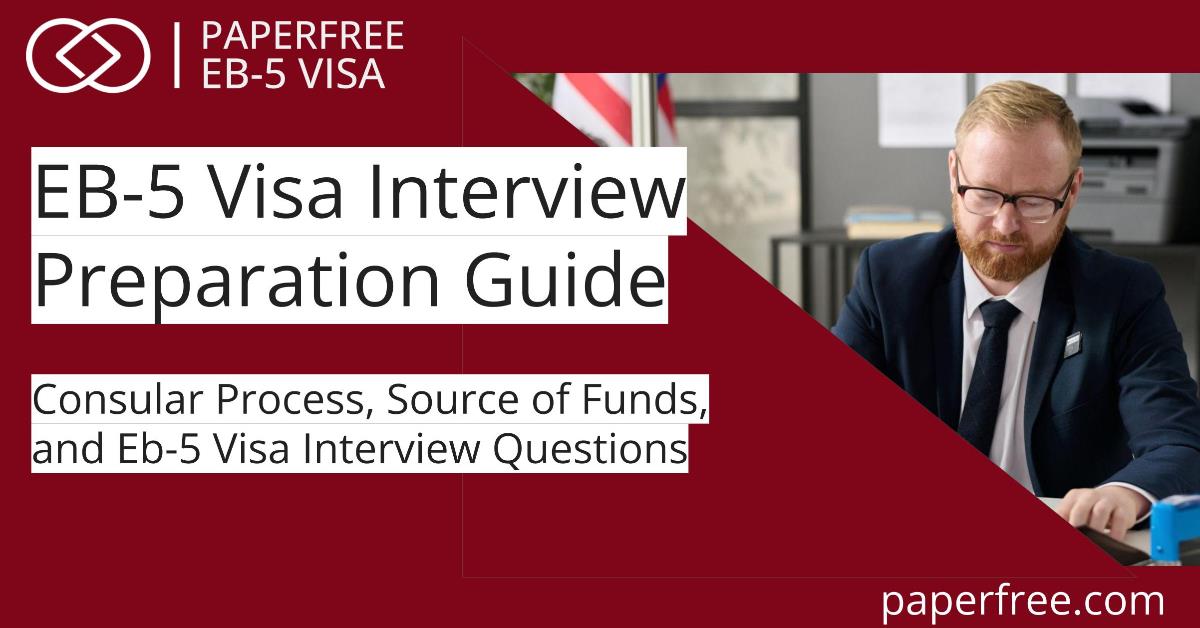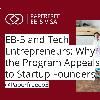EB-5 Visa Interview Preparation Guide: Consular Process, Source of Funds, and Eb-5 Visa Interview Questions
Navigate the EB-5 visa journey confidently with our guide. Master the consular process, source of funds verification, and common Eb-5 Visa Interview Questions for a seamless immigration experience.last updated Wednesday, December 31, 2025
#Eb5 Visa Interview Questions #EB-5 Visa Interview
| | by Sidra Jabeen | Content Manager, Paperfree Magazine |

QUICK LINKS
AD
Get Access to EB 5 Investment Visa Resources
Key Points:
What is the consular process for EB-5?
The consular process for EB-5 is a separate stage that provides for a visa and admission to the U.S. as a legal permanent resident.
The EB-5 Visa Consular Process is the final stage in obtaining your US Green Card through the EB-5 Immigrant Investor Program. It occurs after your I-526 petition has been approved by USCIS, confirming your eligibility to invest in the US and create jobs.
Consular processing can take between 5 to 13 months on average.
Once the application is approved, you can enter the United States as a permanent resident.

Overview of EB-5 visa application stages
Stage 1: Pre-Petition Planning & Preparation
- Eligibility Check
Ensure you meet the program's investment and job creation requirements, including the minimum investment amount ($1 million or $500,000 in targeted employment areas). - Investment Selection
Choose your investment vehicle, whether a direct business investment, regional center project, or other USCIS-approved option. - Financial Documentation
Gather extensive documents proving your lawful source of funds and ability to invest the required amount. - Business Plan Development
For direct investments, create a comprehensive business plan showcasing job creation potential.
Stage 2: I-526 Petition Filing & Processing
- Form I-526 Submission
This form is your official application, detailing your investment, job creation plans, and supporting evidence. - Filing Fees
Pay the associated I-526 filing fee and any other required charges. - Processing & Adjudication
USCIS evaluates your petition to determine if it meets the program's criteria. This can take several months. - I-526 Approval
If successful, you will receive an I-526 approval notice confirming your eligibility to move forward.
Stage 3: Consular Processing & Visa Issuance
- National Visa Center (NVC) Communication
The NVC contacts you and guides you through the visa interview process. - Document Submission
Provide additional documents requested by the NVC, including medical exam results and updated financial information. - Interview Scheduling
Schedule your visa interview at the US Consulate in your home country. - Visa Interview
Attend the interview, and be prepared to answer questions about your investment and immigration history. - Visa Issuance
Upon successful interview and final processing, you receive your immigrant visa, allowing you to enter the US.
Stage 4: Green Card & Post-Landing Requirements
- US Entry & Green Card Claiming
Enter the US within the valid visa timeframe and claim your conditional Green Card. - Investment & Job Creation Verification
Maintain your investment and ensure sustained job creation as per the initial plan. - I-829 Petition Filing
After two years, file Form I-829 to remove the conditional status and obtain a permanent Green Card.
Importance of consular processing for those not in the U.S.
Consular processing, the final hurdle for Green Card seekers outside the U.S., is like the passport stamp to your American dream. It's crucial because:
- Visa Approval
It grants you the official U.S. visa, the key to legally entering and claiming your Green Card. - Background Checks
It ensures you meet U.S. security and eligibility requirements, safeguarding national interests. - Interview Access
It provides a platform to directly address consular officers' concerns and showcase your investment and job creation potential. - Immigration Path Completion
It marks the final step in your journey, paving the way for a new life as a permanent U.S. resident.
So, while it may seem like another obstacle, consular processing is the bridge to reaching your destination.
After an EB-5 petitioner receives approval of their petition, USCIS will send the approved petition to the National Visa Center (NVC). The NVC will then send instructions to the petitioner on applying for a visa through a U.S. consulate or embassy in their country.
The total time for processing of EB 5 visa ranges from 1 to 3 years. Processing times for EB 5 Visa vary for each stage of many applications/ forms involved.
Consular Process Steps
The EB-5 visa application process involves multiple stages. You must go through consular processing if you're not already in the U.S. This involves:
- Completing Form DS-260, the "Application for Immigrant Visa and Alien Registration"
- Getting a medical exam
- Attending an interview at a U.S. consulate or embassy
Filing Form DS-260
- This online form is your immigrant visa application, requiring personal information, travel history, family details, and security questions.
- Complete this form after receiving instructions from the National Visa Center (NVC).
Document Review and Organization
Gather all documents requested by the NVC, including:
- Proof of investment and job creation
- Financial documents
- Medical exam results
- Police certificates
- Passport and travel documents
- Proof of relationships to accompanying family members
- Organize documents neatly and ensure they meet formatting requirements.
Visa Interview Scheduling
- Once your documents are deemed complete by the NVC, you can schedule your visa interview at the US Consulate in your home country.
- Pay the associated visa interview fee before scheduling.
The family-based visa interview questions and process includes a document review, a medical examination, and a personal interview. Depending on the consulate, it can take about six months to set up.
Completing the EB-5 Visa Interview
- Dress professionally and arrive early for your interview.
- Be prepared to answer questions about your investment, job creation, and immigration history.
- Speak clearly and honestly, providing any additional evidence requested by the consular officer.
Based on EB 5 visa interview experience of EB5 investors, the interview process includes a document review, a medical examination, and a personal interview. Depending on the consulate, it can take about six months to set up.
Here are some documents you can prepare for the interview:
- Proof of investment
- Medical reports
- Police certificates
Receiving the EB-5 Visa
- You'll receive your immigrant visa within a few weeks if your interview is successful.
- Use this visa to enter the US within the validity period and claim your Green Card.
Preparation Tips for EB5 interview questions
As of March 2022, the minimum EB-5 visa investment is $800,000 for infrastructure or targeted employment area projects and $1,050,000 for non-TEA projects.
Understanding the Interview's Purpose
- Know that the interview assesses your eligibility for the visa based on three main factors: lawful source of funds, genuine investment in a qualifying project, and potential for job creation.
- Be prepared to demonstrate your understanding of the EB-5 program and its regulations.
Thorough Document Preparation
- Gather all requested documents well in advance and organize them meticulously.
- Ensure each document meets the NVC's formatting and translation requirements.
- Prepare clear and concise explanations for any complex financial records or business plans.
Mock Interviews for Practice
- Conduct mock interviews with an immigration attorney, mentor, or trusted friend familiar with the EB-5 process.
- Simulate the interview format and anticipate potential questions.
- Focus on clear communication, confidence, and addressing concerns directly.
In-depth Research on the Chosen Investment Project
- Demonstrate your deep understanding of the project's business model, financial projections, and job creation potential.
- Be prepared to discuss the project's impact on the local economy and its compliance with EB-5 regulations.
- Research the project's history, management team, and any potential challenges it might face.
Anticipating and Addressing Potential Questions
- Prepare answers to common questions about your source of funds, investment history, and immigration intentions.
- Be ready to clarify any discrepancies or uncertainties in your application or background.
- Avoid vague or emotional responses, and demonstrate a factual and objective approach.
Presenting Yourself Professionally
The EB-5 visa interview is a crucial hurdle in securing U.S. permanent residency. Feeling prepared and confident can significantly impact your success.
The Consular Officer aims to:
- Verify the information in your petition (I-526).
- Assess your eligibility for the EB-5 visa based on admissibility grounds.
- Evaluate your understanding of the investment project and its economic impact.
Dressing Appropriately for the Interview
- Dress as a business professional, aiming for a neat and conservative look.
- Avoid excessively casual attire, flashy jewelry, or strong fragrances.
- Prioritize comfort and confidence without compromising professionalism.
Maintaining Confidence and Courtesy
- Make eye contact, speak clearly and calmly.
- Project a positive and respectful attitude throughout the interview.
- Respond to questions honestly and directly, even if they're challenging.
- Remain patient and avoid defensiveness or negativity.
Active Listening and Thoughtful Responses
- Pay close attention to the interviewer's questions and take a moment to gather your thoughts before answering.
- Avoid interrupting or giving vague or irrelevant responses.
- Tailor your answers to address the specific question being asked.
- Don't be afraid to ask clarifying questions if needed.
Consideration of Interpreters if Needed
- If you require an interpreter, arrange for a certified professional familiar with immigration terminology.
- Speak directly to the interpreter, not the consular officer, and allow them to translate your responses accurately.
- Maintain eye contact with the consular officer as much as possible to demonstrate good communication and engagement.
Essential Documents for Consular Interview
Passport and Passport Copies
- Bring your original passport and several copies of the bio-data page.
- Ensure your passport is valid for at least six months beyond your intended entry date to the US.
- You'll also need legible copies of your passport, including blank pages.
Birth Certificate
- Provide an original or certified copy of your birth certificate.
- This verifies your identity and the relationships associated with your visa.
Marriage Certificates or Divorce Decrees
- If applicable, provide originals or certified copies of your marriage certificate and divorce decrees.
- Married applicants need an original or certified copy of their marriage certificate. Applicants who have been previously married need evidence of the termination of each prior marriage.
Passport Photographs
- Bring several recent passport-sized photographs meeting the required specifications.
- Two photos, taken within the last six months, showing your full face against a white background. The photos must be printed on photo paper and sized 1.5 x 1.5 inches (5 cm x 5 cm).
Police Clearance Certificate (PCC)
- Obtain a PCC from your home country and any other countries you've resided in for more than six months since the age of 16.
Court and Prison Records (if applicable)
- Be prepared to provide documentation of any court or prison records, if applicable.
- Applicants in court or prison must present certified copies of each court or prison record and certified English translations.
Application Fee Payment Receipt
- Bring a copy of your receipt for the visa interview fee payment.
Consular Processing Timeline
Average Processing Time (5 to 13 months)
- Be aware that the consular processing timeline can vary depending on individual circumstances, workload at the consulate, and unforeseen delays.
- However, the average processing time typically falls 5 to 13 months from the interview date.
- Stay patient and in communication with the NVC for updates on your case progress.
Steps from Immigrant Petition to Visa Approval
- I-526 Petition Approval
USCIS must approve your initial petition demonstrating investment and job creation. - NVC Communication
The National Visa Center will receive your case after USCIS approval and guide you through the visa interview process. - Document Submission
Provide additional documents requested by the NVC, including medical exam results and updated financial information. - Visa Interview Scheduling
Schedule your visa interview at the US Consulate in your home country. - Visa Interview
Attend the interview and be prepared to answer questions about your investment and immigration history. - Administrative Processing
The consulate and possibly USCIS may further scrutinize your case after the interview. - Visa Issuance
If your application is approved, you'll receive your immigrant visa, allowing you to enter the US and claim your Green Card.
Steps to Convert from Consular Processing to Adjustment of Status | NVC Time Frame
- Determine Eligibility
Ensure you meet the requirements for adjustment of status, including:- Physical presence in the US
- Lawful entry into the US (with few exceptions)
- No visa overstays or immigration violations
- Notify NVC
Inform the National Visa Center (NVC) of your intention to switch to adjustment of status. They'll halt consular processing and transfer your case to USCIS. - File Form I-485
Complete and submit Form I-485, Application to Register Permanent Residence or Adjust Status, and supporting documentation to USCIS. - Biometrics Appointment
Attend a biometrics appointment to provide fingerprints and photographs. - Interview (if applicable)
USCIS may schedule an interview to review your application and verify information. - Decision
USCIS will either approve or deny your adjustment of status application.
Filing Form I-485 with USCIS
- Required Documents
- Form I-485
- Filing fee
- Copy of approved I-526 petition
- Medical examination results
- Two passport-style photos
- Evidence of lawful entry (e.g., passport stamps, I-94)
- Proof of continuous physical presence in the US
- Financial documents demonstrating the ability to support yourself
- Other relevant documents, depending on your situation
- Filing Location
- File Form I-485 with the USCIS field office with jurisdiction over your residence.
- Processing Time
- Adjustment of status processing times vary but generally range from 6 to 12 months.
Key Considerations:
- Timing
Switching to adjustment of status may delay your Green Card process, so carefully weigh the pros and cons. - Professional Guidance
Consult an immigration attorney to ensure a smooth transition and avoid potential pitfalls. - Eligibility
Not all EB-5 applicants are eligible for adjustment of status, so meticulous assessment of your circumstances is crucial.
AOS vs. Consular Processing: Weighing Your Options
Adjustment of Status (AOS) and consular processing offer paths to US Green Cards for EB-5 investors, but each has advantages and disadvantages. Choosing the correct route depends on your circumstances and priorities.
Pros and Cons of Adjustment of Status (AOS)
Pros
- Convenience to travel
No need to travel abroad for the interview.- Potentially faster processing
AOS processing times tend to be faster than consular processing (6-12 months vs. 5-13 months on average). - Greater access to legal assistance
Easier to consult with US-based immigration attorneys. - Travel flexibility
You can travel freely within the US while your application is pending.
- Potentially faster processing
Cons
- Eligibility Restrictions
Only available to EB-5 investors already lawfully present in the US. - Potential delays
USCIS processing times can vary and sometimes exceed estimates. - Interview uncertainty
Interviews are not always required, but USCIS may schedule one at their discretion. - Limited legal options
Appeal options might be limited if an adjustment application is denied.
Differences in Processing Time, Benefits, Access to Officials, and Travel Considerations
- Processing Time
- AOS: 6-12 months on average.
- Consular Processing: 5-13 months on average.
- Benefits
- Both paths ultimately lead to a Green Card.
- AOS allows immediate access to certain federal benefits and work authorization.
- Access to Officials
- AOS
Easier access to US-based attorneys and USCIS officials. - Consular Processing
Interview with a consular officer at the US Consulate in your home country.
- AOS
- Travel Considerations
- AOS
Travel is permitted within the US while your application is pending. - Consular Processing
You must be in your home country for the interview and visa issuance.
- AOS
Ultimately, your best path depends on your circumstances and risk tolerance. Consider factors like your current location, desired timeline, travel plans, and potential for legal complications. Consulting with an experienced immigration attorney is highly recommended to assess your eligibility and choose the most suitable option.
Comparing Processing Times
Overview of EB-5 Visa Process Duration
The EB-5 visa process is notorious for its multi-stage nature, each with its timeframe:
- Pre-Petition Planning & Preparation
Months of planning, choosing an investment, and gathering documents. - I-526 Petition Filing & Processing
It can take 12-36 months due to the USCIS workload and petition complexity. - Consular Processing & Visa Issuance
5-13 months on average, involving document review, interview, and administrative checks. - Green Card Removal of Conditions
After two years, file Form I-829, taking an additional 6-12 months.
Total EB-5 Process Time
Expect anywhere from 20 to 48 months from initial planning to permanent Green Card in hand.
Contrasting EB-5 Visa Processing Time with Other Green Card Categories
- Employment-Based (EB)
Specific categories like EB-1 (extraordinary ability) offer faster processing (under six months), while others like EB-2 (skilled workers) and EB-3 (professionals/unskilled workers) can take 12-36 months, comparable to EB-5 initially. - Family-Based
Spouses and minor children of US citizens typically see quicker processing (6-12 months), while other categories like siblings and parents can face lengthy backlogs of years. - Diversity Visa (DV)
Entries are limited through a lottery, but processing for selected applicants can be relatively fast (12-18 months) once selected.
Key Takeaways
- EB-5 processing is among the longest Green Card paths, requiring patience and planning.
- While the initial stages of EB-5 may align with specific EB categories, the process takes significantly longer.
- Family-based and DV categories can offer faster options if eligible.
Lawful Source of EB-5 Investment
Demonstrating the lawful source of your EB-5 investment is paramount. Be prepared to show a clear paper trail and provide comprehensive documentation for every penny used. Familiar, acceptable sources include:
- Employment earnings
Salary, bonuses, and dividends from verifiable sources. - Capital gains
Proceeds from the sale of assets like stocks, property, or businesses. - Inheritance or gifts
Documented inheritances or gifts from legally close relatives. - Loans
Secured loans from reputable financial institutions with clear repayment plans.
Provide detailed documentation, such as:
- Tax returns
- Bank statements
- Sales contracts
- Loan agreements
- Investment records
Remember, transparency and thoroughness are key. Ensure your source of funds story is consistent and aligns with supporting evidence.
Expanding on Acceptable Sources
- Briefly explain acceptable proof for each source category. For example, for employment earnings, mention pay stubs, W-2 forms, and tax returns.
Employment Earnings
Acceptable proof of employment earnings includes pay stubs, W-2 forms, and tax returns. These documents provide a clear record of income, ensuring transparency in the source verification process.
Business Income
For business income, acceptable proof involves providing financial statements, tax returns, and business registration documents. These documents demonstrate the legitimacy and stability of the business as a source of funds.
Investment Income
Verification for investment income can be supported by presenting brokerage statements, dividend records, and capital gains statements. These documents serve as evidence of income generated through investments.
Real Estate Income
For income from real estate, acceptable proof includes rental agreements, lease documents, and property income statements. These documents substantiate the regular income flow from real estate investments.
- Mention other potential sources besides those listed, like pension funds, life insurance payouts, or business sales.
Apart from the mentioned categories, acceptable sources may also include pension funds, life insurance payouts, or proceeds from the sale of a business. Pension fund statements, life insurance documentation, and business sales agreements can be provided as proof for these alternative sources.
Gifted Funds
In the case of gifted funds, acceptable proof involves a gift letter from the donor documenting the intention to gift funds and proof of the donor's financial capability, such as bank statements.
Inheritance
For funds received through inheritance, acceptable proof includes the inheritance documents, probate records, and any legal documentation confirming the transfer of assets.
These sources and their corresponding proofs ensure a comprehensive evaluation of the funds' legitimacy and adherence to USCIS requirements. Providing clear and organized documentation is essential to facilitate the verification process.
Strengthening Documentation Tips
- Describe the ideal format and organization for documents. Advise using binders, tabs, and clear labeling for easy review by the consular officer.
Ideal Format and Organization for Documents
The ideal format for documentation involves presenting a well-organized set of materials in binders or folders. Use tabs and clear labels for each section to facilitate easy review by the consular officer. Arrange documents in chronological order, grouping related items. Mark the beginning of each section, such as employment records, financial statements, or legal documents, to enhance clarity and efficiency during the review process. - Suggest translations if necessary, emphasizing certified translations by professional services.
Translations for Documents
If documents are not in English, provide certified translations by professional services. Ensure that translations are accurate and complete and mirror the original documents precisely. Label translated documents and, if applicable, attach a certification of translation accuracy. This approach ensures that the consular officer can confidently interpret and evaluate the information presented. - Mention potential red flags in documentation, like unexplained gaps or inconsistencies.
Be attentive to potential red flags in documentation, such as unexplained gaps or inconsistencies. If there are breaks in employment history or financial records, provide a brief and transparent explanation for these gaps. Consistency is key – cross-check all documents to ensure harmony in details. If any inconsistencies arise, offer clarifications or additional supporting documentation to address concerns promptly. This proactive approach contributes to a smoother and more favorable review process. - Supporting Affidavits or Letters
Consider supplementing documentation with supporting affidavits or letters explaining specific circumstances. For instance, if there is a change in employment or a unique financial transaction, a letter outlining the details can provide context and alleviate potential concerns. - Additional Tips:
- Document Integrity
Ensure that all documents are complete, legible, and free from alterations. Any changes or additions should be clearly explained and supported. - Organization Clarity
Maintain a clear and logical organization of documents, making it easy for the consular officer to follow the narrative of your financial and personal history. - Professionalism
Professionally present all documents, reflecting attention to detail and a commitment to transparency.
By adhering to these tips, applicants can significantly strengthen their documentation, minimizing the likelihood of misunderstandings and ensuring a more efficient and positive visa application process.
- Document Integrity
Emphasizing Transparency and Consistency
- Provide concrete examples of maintaining a consistent "source of funds story" throughout the application process.
Consistency in the "source of funds story" is crucial for a successful EB-5 visa application. For example, if the stated source of funds is employment income, ensure that all related documents, such as pay stubs, tax returns, and employment verification letters, consistently reflect this narrative. If there is a transition in income sources, provide clear documentation and an accompanying narrative explaining the change to maintain transparency.
- Recommend preparing a narrative document summarizing the source of funds and its flow to the investment, aligned with supporting evidence.
To enhance the application, prepare a comprehensive narrative document summarizing the source of funds and its flow to the investment. Begin with the origin of the funds, detailing the employment, business, or investment activities that generated the income. Provide a clear timeline of the funds' journey, including any financial transactions or investments. Align this narrative with supporting evidence, such as bank statements, tax returns, and business records, to reinforce the legitimacy of the source of funds.
- Advise against attempting to conceal or misrepresent any information, as it can lead to visa denial.
- Maintaining a Consistent "Source of Funds Story"
Consistency in the "source of funds story" is crucial for a successful EB-5 visa application. For example, if the stated source of funds is employment income, ensure that all related documents, such as pay stubs, tax returns, and employment verification letters, consistently reflect this narrative. If there is a transition in income sources, provide clear documentation and an accompanying narrative explaining the change to maintain transparency. - Preparing a Narrative Document
To enhance the application, prepare a comprehensive narrative document summarizing the source of funds and its flow to the investment. Begin with the origin of the funds, detailing the employment, business, or investment activities that generated the income. Provide a clear timeline of the funds' journey, including any financial transactions or investments. Align this narrative with supporting evidence, such as bank statements, tax returns, and business records, to reinforce the legitimacy of the source of funds. - Advising Against Concealment or Misrepresentation
It is imperative to advise against any attempts to conceal or misrepresent information during the application process. Such actions can lead to severe consequences, including visa denial. Full transparency is essential, even if certain aspects seem complex or challenging to explain. Consistent and honest communication, supported by proper documentation, strengthens the application and establishes credibility with the consular officer reviewing the case.
Examples of Consistent Sources of Funds Story
- Employment Income Transition
If there is a transition from employment income to business ownership, provide documentation and a narrative explaining the career move, demonstrating how the new business aligns with the applicant's professional background. - Investment Proceeds
If the source of funds includes returns from investments, consistently showcase the investment portfolio, detailing the initial investment, subsequent returns, and how these funds are earmarked for the EB-5 investment. - Gifted Funds
For gifted funds, maintain consistency by presenting a gift letter and supporting evidence of the donor's financial capability and the transfer of funds. This ensures a clear and transparent path from the donor to the investment.
Click here to learn about how to switch from h1b to eb5 visa?
Book Your Free Consultation with Paperfree EB-5 Visa Experts. Get Personalized Advice and Investment Plans. Book Your Free Consultation Today!

EB5 Visa Interview Questions
Personal and Investment Background
- Q: Can you provide an overview of your professional background and experience?
A: Be ready to discuss your work history, educational qualifications, and any relevant skills or achievements. This helps establish your financial stability and potential contribution to the US economy. - Q: What motivated you to pursue the EB-5 Visa program and invest in the U.S.?
A: Explain your reasons for choosing the EB-5 program and investing in the US. Highlight factors like family ties, business opportunities, or educational aspirations. - Q: How did you accumulate the funds for your EB-5 investment, and can you provide documentation supporting the source of these funds?
A: Be prepared to demonstrate the lawful origin of your EB-5 investment funds. This may involve providing bank statements, tax returns, employment records, or other supporting documents. - Q: What factors influenced your choice of the specific regional center for your investment?
A: Explain your research and decision-making process regarding the specific regional center you invested in. Highlight project details, track record, location, and alignment with your investment goals.
Source of Funds
- Q: Can you elaborate on the legal sources of your funds in the EB-5 program?
A: Funds originate from legal sources, including verifiable employment income, business profits, and documented investments. Supporting documentation, such as tax returns, pay stubs, and business financial statements, attests to the legitimacy of these funds. - Q: How do you plan to transfer the investment funds from your source to the New Commercial Enterprise (NCE) and the job-creating project?
A: Secure transfer methods, adhering to legal protocols, will move funds from the personal account to the New Commercial Enterprise (NCE). This process ensures traceability and subsequent deployment to the job-creating project follows regulatory guidelines. - Q: What steps have you taken to ensure compliance with U.S. financial regulations in the sourcing and transfer of your investment funds?
A: Engagement with legal and financial professionals possessing expertise in EB-5 regulations guarantees compliance. Collaboration with a reputable bank facilitates lawful fund transfers. Rigorous documentation accompanies every transaction to meet and exceed U.S. regulatory standards.
Business Plan and Job Creation
- Q: How familiar are you with the business plan associated with your EB-5 investment, and how does it align with the USCIS requirements?
A: In-depth understanding of the business plan linked to the EB-5 investment, ensuring alignment with USCIS requirements. The plan meticulously details the business structure, financial projections, and job creation strategies in accordance with guidelines set forth by USCIS. - Q: Can you provide details about the job creation strategy outlined in the business plan and the expected timeline for job generation?
A: The business plan outlines a comprehensive job creation strategy, emphasizing sustained employment growth. The anticipated timeline for job generation is detailed, with clear milestones. Strategies include workforce expansion, skill development, and strategic hiring to meet and exceed USCIS requirements. - Q: How confident are you in the success of the project and its contribution to job creation in the designated regional center?
A: Confidence in the project's success and substantial contribution to job creation in the designated regional center. The business plan's robust strategies, coupled with a thorough risk mitigation plan, instill confidence in the project's ability to thrive and positively impact employment opportunities in the specified timeframe.
Regional Center and Economic Impact
- Q: When selecting the regional center for your EB-5 investment? What criteria did you consider?
A: The selection of the regional center was based on a meticulous evaluation of various criteria. Factors such as the center's track record, compliance with USCIS guidelines, history of successful projects, and impact on job creation were crucial considerations. Additionally, the center's commitment to transparency and positive community influence was pivotal in the decision-making process. - Q: How do you foresee your investment contributing to the U.S. economy and promoting economic development in the designated area?
A: The investment is anticipated to make a meaningful contribution to the U.S. economy by promoting economic development in the designated area. Through the creation of jobs, enhancement of infrastructure, and support for local businesses, the investment aims to stimulate economic growth. The goal is to meet USCIS requirements and actively participate in the region's prosperity and development.
Current Status and Future Plans
- Q: Can you provide an update on the progress of your EB-5 investment since filing the I-526 petition?
A: Since filing the I-526 petition, significant progress has been achieved in the EB-5 investment. Milestones include [mention key developments, such as project approvals, fund transfers, or any other pertinent advancements]. Regular updates from the project management team ensure transparency and compliance with USCIS requirements. - Q: How do you plan to actively participate in the management or oversight of the EB-5 project?
A: Actively participating in the management and oversight of the EB-5 project is a key focus. Engagement includes [mention specific activities, such as regular communication with project managers, attending meetings, or reviewing progress reports]. This hands-on approach ensures effective oversight, contributing to the project's success and alignment with USCIS expectations.
Miscellaneous
- Q: Are you aware of any recent changes in U.S. immigration policies or EB-5 regulations that may impact your application?
A: Keenly aware of any recent changes in U.S. immigration policies or EB-5 regulations that may impact the application. Regular updates from legal counsel and ongoing monitoring of USCIS announcements ensure prompt awareness and adaptation to any alterations in the regulatory landscape. - Q: How do you plan to address any unforeseen challenges or risks associated with your EB-5 investment?
A: Proactively planning to address any unforeseen challenges or risks associated with the EB-5 investment. This involves maintaining a dynamic risk mitigation strategy, regularly assessing project performance, and collaborating closely with legal and financial advisors. The goal is to swiftly address challenges as they arise, ensuring the continued success and compliance of the investment.
Financial Stability and Intent
- Q: Can you explain your financial stability and how your investment in the U.S. aligns with your overall financial goals?
A: Financial stability is demonstrated through a comprehensive assessment of assets, income sources, and investment portfolios. The U.S. investment aligns seamlessly with overarching financial goals, diversifying the portfolio and contributing to long-term wealth growth. This strategic investment ensures a balanced and resilient financial foundation. - Q: What assurances do you have that your investment funds will be at risk and committed to the EB-5 project for the required period?
A: Assurances are in place to substantiate the investment funds' commitment and "at-risk" status throughout the required period. Legal agreements, financial instruments, and project documentation outline the terms and conditions safeguarding the funds' dedication to the EB-5 project. These mechanisms ensure adherence to USCIS guidelines, instilling confidence in the sustained commitment to the investment.
Legal Compliance and Background Check
- Q: Have you ever been involved in legal proceedings or faced legal challenges in your home country or abroad?
A: No involvement in legal proceedings or faced legal challenges in my home country or abroad. My legal record is clean without legal complications, ensuring a smooth and transparent EB-5 application process. - Q: Can you confirm that all the information in your EB-5 application is accurate and complete?
A: Confirmation that all information in the EB-5 application is accurate and complete. Thorough diligence has been applied to ensure the precision of the details provided. Any oversight or omission was unintentional, and I am fully committed to cooperating with authorities to rectify and supplement any required information promptly.
Language Proficiency
- Q: How comfortable are you with English, and how do you plan to overcome language barriers while managing your investment in the U.S.?
- A: Comfort with the English Language
Proficient and comfortable with the English language, ensuring effective communication and comprehension. This proficiency facilitates seamless interaction with project stakeholders, legal advisors, and other relevant parties throughout the management of the U.S. investment. - A: Overcoming Language Barriers in Managing U.S. Investment
Proactive measures are in place to overcome potential language barriers in managing the U.S. investment. These include hiring language support services when needed, engaging bilingual professionals, and participating in language enhancement programs. These efforts ensure clear communication and understanding, contributing to the successful management of the investment.
- A: Comfort with the English Language
Tax Implications
- Q: Are you aware of the tax implications of your EB-5 investment in both your home country and the U.S.?
A: Fully aware of the tax implications associated with the EB-5 investment in both my home country and the U.S. Comprehensive consultation with tax professionals ensures a clear understanding of tax obligations, facilitating compliance with the tax regulations of both jurisdictions.
Exit Strategy
- Q: What is your exit strategy if the EB-5 project does not proceed as planned or if there are challenges in achieving the targeted job creation goals?
A: A structured exit strategy is in place if the EB-5 project encounters challenges or deviates from the initial plan. This strategy is designed to safeguard the investment and mitigate potential risks. Specific details of the exit plan include [mention critical components, such as selling the investment, renegotiating terms, or alternative project considerations]. Regular assessments and collaboration with legal and financial advisors ensure adaptability to unforeseen circumstances while protecting the investment's integrity.
Impact of External Factors
- Q: How do you plan to mitigate potential challenges such as economic downturns, changes in government policies, or other external factors that may impact your EB-5 investment?
A: A comprehensive strategy is in place to mitigate potential challenges arising from external factors that may impact the EB-5 investment. This strategy involves regular monitoring of economic indicators and government policies to anticipate and adapt to changes.
Diversifying the investment portfolio and engaging with experienced professionals in legal and financial fields provide a proactive approach to navigating economic downturns or policy shifts. This adaptability ensures resilience and safeguards the long-term success of the EB-5 investment.
Employment and Business Ties
- Q: What are your current employment status and business affiliations in your home country, and how do they align with your plans for the EB-5 investment?
- A: Current Employment Status and Business Affiliations
The current employment status in the home country is [provide details, such as employed, self-employed, or business owner]. Additionally, there is an affiliation with [mention business affiliations or ventures], contributing to the overall financial standing. - A: Alignment with EB-5 Investment Plans
These current employment and business affiliations align seamlessly with plans for the EB-5 investment. The skills and experiences gained from professional endeavors enhance the ability to actively participate in and contribute to the success of the U.S. investment project. This alignment ensures a holistic financial stability and growth approach through diversified sources.
- A: Current Employment Status and Business Affiliations
Residency Intentions
- Q: Can you elaborate on your intentions regarding residency in the U.S. and how you plan to fulfill the residency requirements associated with the EB-5 Visa?
A: Intentions regarding residency in the U.S. involve establishing a permanent and active presence to engage with the EB-5 investment actively. Plans to fulfill residency requirements include [mention specific activities, such as regular stays, involvement in project oversight, and compliance with USCIS guidelines]. This commitment ensures adherence to the residency obligations associated with the EB-5 Visa, demonstrating a genuine and ongoing commitment to the U.S. as a permanent residence.
Communication with the Regional Center
- Q: How have you communicated with the regional center, and what assurances do you have regarding the ongoing communication and transparency of the project management?
- A: Communication with the Regional Center
communication with the regional center has been established through regular meetings, correspondence, and participation in updates provided by the project management team. This ensures an ongoing and open channel for information exchange. - Assurances Regarding Ongoing Communication and Transparency
Assurances regarding ongoing communication and transparency are based on the regional center's commitment to regular updates, progress reports, and timely responses to inquiries. Legal agreements and project documentation reinforce the expectations for transparent communication, providing confidence in the continued openness and accessibility of the project management throughout the EB-5 investment.
- A: Communication with the Regional Center
Community Engagement
- Q: Do you have any plans for community engagement or involvement in the designated regional center area where your EB-5 investment is located?
A: Plans for community engagement involve actively participating in initiatives within the designated regional center area where the EB-5 investment is located. This includes [mention specific activities, such as supporting local businesses, participating in community events, or contributing to charitable endeavors]. The aim is to establish a positive presence, foster community connections, and contribute to the overall well-being and development of the local area.
Frequently Asked Questions About EB-5 Visa Interview:
What should I expect during my EB-5 Visa interview?
Expect questions about your investment, the source of funds, your background, and your intentions in the U.S. The consular officer will assess whether your investment meets the EB-5 program requirements.
Can you change your passport during EB-5?
You can change your passport during the EB-5 process, but it requires careful documentation and communication with USCIS or the consular office handling your case. However, changing your citizenship or passport nationality will not affect your EB-5 visa processing time or priority date. The EB-5 visa queue and waiting time are based on your country of birth, not your current citizenship or passport.
How can I prepare for my interview for the EB-5 Visa?
Preparation should include reviewing your application, understanding the specifics of your investment, having a clear timeline of your financial transactions, and practicing answers to potential questions.
What documents should I bring to my EB-5 Visa consular session?
Bring your passport, DS-260 confirmation page, financial documents proving the source and path of your funds, business documents related to your EB-5 project, and any previous immigration forms.
Can you outline the typical procedure for an EB-5 Visa interview at the consulate?
The procedure typically includes document verification, a face-to-face interview with a consular officer, and questions aimed explicitly at validating your EB-5 project and investment.
What tips can help me succeed in my EB-5 Visa interview?
Be honest, maintain clear and consistent answers, understand your investment in detail, and demonstrate your commitment to the success of the EB-5 project.
How long does the EB-5 Visa interview process typically take?
The interview itself usually lasts between 15 to 30 minutes, but waiting times at the consulate can vary significantly.
What are the key focus areas during an EB-5 consular interview?
Key areas include the legitimacy of your funds, the viability of the EB-5 project, your ties to your home country, and your plans in the U.S.
How can I demonstrate my investment is at risk during the EB-5 interview?
Show detailed project plans, financial forecasts, and evidence of active participation in your business to prove your investment meets the "at risk" requirement of the EB-5 program.
What happens if my interview is not successful?
Consult an immigration attorney to understand the reasons for denial and potential appeal options.
Can I expedite my processing?
Expedited processing may be available under specific circumstances; consult the NVC website for details.
What happens after I receive my visa?
Enter the US within the valid visa timeframe and claim your conditional Green Card. Maintain your investment and job creation as per the initial plan. After two years, file Form I-829 to remove the conditional status and obtain a permanent Green Card.
Where can I find more information?
For personalized guidance, refer to the National Visa Center and USCIS websites, or consult with an experienced immigration attorney.
Which is faster: adjustment of status or green card?
The EB-5 visa process can be faster than other U.S. green card categories. The EB-5 visa process can take 13 months, but the processing time can vary. The EB-5 visa process can also take 1–3 years, from filing the EB-5 application to approving the permanent green card.
The Green Card processing time depends on the type of green card you are applying for, the location of the processing office, and other factors. It can take 7–33 months to process a green card application. In most cases, it takes about two years for a green card to become available, and the entire process takes around three years.
CONCLUSION
The EB-5 visa journey, while potentially transformative, can be complex and daunting. Remember, meticulous preparation is critical to unlocking its doors.
Embrace knowledge and seek professional guidance. Invest in understanding the process, its stages, and potential hurdles. Consult with experienced immigration attorneys who can tailor advice to your circumstances, investment choice, and timeline.
Acknowledge that your path is unique. Immigration timelines, challenges, and opportunities vary based on individual circumstances and global factors. Personalized guidance from qualified professionals will illuminate your specific roadmap to success.
Approach your EB-5 journey with patience, diligence, and informed optimism. With careful preparation, proactive problem-solving, and the proper support, you can navigate the intricacies and emerge triumphantly, ready to embark on your new chapter in the United States.
Pages Related to #Eb5 Visa Interview Questions
- Papefree EB5 investors magazine your source for EB5 insights. EB5 News.

- EB5 Investment Visa Guide 2025

- Paperfree Investment Visa EB-5 Program is Your Your Clear Path to Green Card USA

- US Immigration: Big increase in EB–5 visa fees proposed

- July 2025 Visa Bulletin: EB-5 Investment Visa Program Shows Positive Movement

- EB-5 for Tech Entrepreneurs: Immigration Program for Startup Founders | Paperfree

- EB-5 Visa Residency Requirements. Is EB 5 Visa for Me? Other visa options EB5 vs E2 vs L1

- EB-5 Investment Protection: How Experienced Developers Safeguard Your Capital | Paperfree

Popular Page
Benefits of the EB-5 Visa Program| A Comprehensive Guide
Book a Free Complimentary Call
real estate investing Investment Visa USA Investment Magazine Private Real Estate Funds real estate funds
